Invicta Flies - All About Biots, page 2
Biots as body material. For each biot, there are two different ways to wind the fiber around the shank to get a different look. When you pull a biot from the stem, you will notice the notched butt end curls. Tying the biot in with the curl up gives a different effect than tying it in with the curl down. Which method produces which effect depends upon whether the biot was stripped from the feather of a right wing or a left wing. The chart below shows the effects and the corresponding "curl direction" to achieve either a smooth or ribbed body, using biots from a LEFT wing feather.
Tying biot in this way:
|
Gives this result:
|
 Wild turkey, left wing, curl down.
|
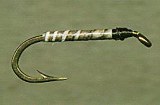 |
 Wild turkey, left wing, curl up.
|
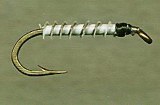 |
 Dyed turkey, left wing, curl down.
|
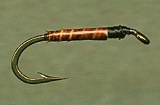 |
 Dyed turkey, left wing, curl up.
|
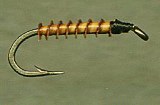 |
Using biots from a right wing feather will yield opposite results. For instance, tying in a right wing biot with the curl down will produce a ribbed body, while tying it in with the curl up will produce a smooth body.
 Hen pheasant, right wing, curl up.
|
 |
 Hen pheasant, right wing, curl down.
|
 |
To determine which wing store-bought biot feathers are from, hold the feather horizontal so the tip curves downward. The top side of the feather will be at the top of the curve. The inside of the curved feather is the bottom and is often shinier than the top. Turn the feather until the flattened, short fiber side (the biots) is facing away from you. This is the leading edge and is the front of the feather if you were to look at the back of a bird with outstretched wings. Holding the feather by the butt, if the tip is to your left, it is from the left wing. Same with the right.
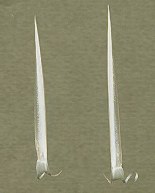 Left wing biot, right wing biot.
|
Some biots are sold apart from the stem in a long curled strip. You can still tell which wing it is from by the shape of the biot itself. Strip a biot off the section and hold it up so the butt end is curled away from you as shown in the photo. You will see one side is thick and has a ridge running all the way to its tip (what forms the ribbed effect), and the other side is very thin and almost transparent. The thin side corresponds to the wing it is from. For example, if the thin side is on the left, the biot is from the feather of the left wing.
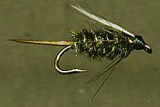 |
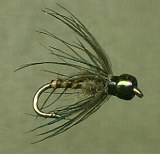 |
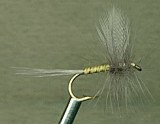 |
END